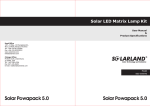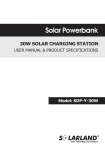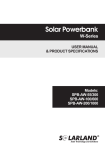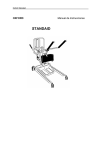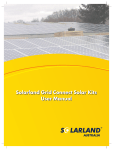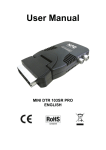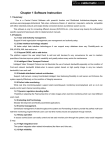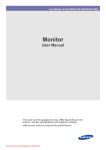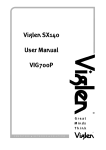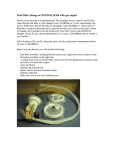Download Installation - Wholesale Solar
Transcript
The Portable, Folding, Solar Battery Charging System USER MANUAL Model: SLP090F-12S and SLP130F-12S Dear Customer, Thank you for purchasing this Solarland product. Please read the instructions carefully and thoroughly before using. Index 1. Description of Functions Page 1 2. Features Page 1 3. Components Page 3 4. Specifications Page 4 5. Installation & Connection Page 5 6. Display Functions in normal operation Page 7 7. Trouble-shooting Guide Page 8 6. Safety Recommendations Page 9 9. Frequently Asked Questions Page 10 10. Typical Battery Connections Page 11 11. Incorrect Battery Connections Page 12 1. Description of Functions This Solar Battery Charging Kit is used to charge 12V lead-acid, AGM, or GEL batteries or battery banks. The system includes the following items: -Two folding solar panels -Solar charge controller -16’ of interconnect cable -Ring terminal adapter -Cigar lighter plug adapter -Cigar lighter socket adapter -Battery clip adapter -Anchoring stakes -Adjustable Support Legs -Adjustable straps -Carrying handle -Padded, metal storage case The Solarland solar charge controller protects the battery or battery bank from being overcharged by the PV module. The charging characteristics include bulk, absorbtion, float and PWM charging stages which Improve the charging efficiency of the system. The Solarland Solar Battery Charging Systems are perfect for charging and maintaining 12V battery systems in the following vehicles and devices: -RV’s -Boats and Marine -Trailers (horse and travel) -Cabins and Cottages -Construction and farm equipment -Material Handling equipment -Camping -Automotive -Aircraft -ATV and Snowmobile -Motorcycle -Disaster Preparedness The Solarland Solar Battery Charging System is intended for use with almost any 12V battery system. 2. Features The Carrying Case The Carrying Case is manufactured from high grade aluminum with the inside finished with durable, padded foam providing excellent protection against damage to the solar panels during transportation and storage. Reinforced corner and gusset protectors are added where they are most needed. The Carrying Handle and Tamper Proof Fasteners The heavy duty Carrying Handle is fitted to the Portable Solar Battery Charging System using tamper-proof hardware. This configuration provides the user with a comfortable way to carry the system and, at the same time, a secure point to affix a security lock and cable (sold separately). 1 Integrated Smart Solar Charge Controller with LED Indication The Solar Charge Controller is mounted behind the solar panels. The Controller ensures that the battery charging is done safely and correctly and without damage to the Solar System or the Battery Bank. The Charge Controller employs a three stage PWM type charging profile for optimal battery charging. A switch on the controller enables the user to select between Lead-acid type batteries or GEL type. And, a protection circuit prevents damage to the controller if the battery leads are accidentally connected incorrectly. The Portable Solar Battery Charging System is completely automatic and designed to be connected to the battery bank indefinitely. Fold Away Adjustable Support Legs A unique folding system of tilt legs are easy to open, close and adjust by simply moving the belts and brackets behind the solar panels. This keeps the solar panels at any desired tilt angle without slipping. By adjusting the angle of the solar panels throughout the day, maximum sun exposure is achieved yielding maximum power output and faster battery charging. Connecting Cables The Portable Folding Solar Battery Charging System comes complete with a 16’ cable that extends from the controller. The cable features an in-line fuse and a two pin moulded connector enabling any one of four battery connection adapters to be quickly added. The battery connection adapters are as follows: -Ring Terminal Adapter. This adapter attaches permanently to your battery or battery bank and remains in place at all times, even when the Solar Panel System is not in use. It is ideal for a battery that is inconveniently located or where the battery terminals are not easily reached. -Battery Clips. Use this adapter when temporary attachment to the battery bank is desired. -Cigar Lighter Plug. Use this adapter when you wish to charge the battery using a cigar lighter socket that might already be installed in the vehicle. This method can work well provided the cigar lighter socket is ‘hot’ all all times and that the socket’s circuit is fused at 10 amps or higher. -Cigar lighter socket. Use this adapter to charge a battery powered device where the device to be charged is already equipped with a cigar lighter plug. It is important to point out that this will not work with all devices. For example, some devices such as cell phones or laptop computers have electronic circuitry between the device and the cigar lighter plug. This circuitry can sometimes prevent the Solar Charge Controller from activating. If you have further questions about the use of this adapter, or if you need further assistance, contact your nearest dealer. 2 3. Components 3 2 1 7 4 5 10 8 9 6 11 Number 1 Description SLP090F-12S SLP130F-12S Folding 2 x 45w multi-crystalline silicon solar panels Folding 2 x 65w multi-crystalline silicon solar panels Qty 1set 2 Automatic smart solar change controller 1pc 3 Rubber Corner Protector 8pcs 4 Heave duty anodized aluminium folding support leg 2pcs 5 Adjustable belt for support legs 2pcs 6 Tent stake 2pcs 7 Heavy duty ABS handle 1pc 8 16’ cable with heavy duty male/female moulded connectors, polarity keyed, plug/socket, fuse and fuse holder provided. 1pc 9 Battery wire with ring terminals 1pc 10 Battery wire with clamps 1pc 11 Car cigarette lighter plug/socket 1set 3 4. Specifications Solar Panel Type Rated Power (Pm) 90W Multi-Crystalline silicon solar cell 130W Multi-Crystalline silicon solar cell 90W (2 x 45W panels in series) 130W (2 x 65W panels in series) Operating Voltage (Vmp) 17.2V 17.2V Operating Current (Imp) 5.23A 7.56A Open Circuit Voltage (Voc) 21.6V 21.6V Short Circuit Current (Isc) 5.75A 8.31A ±5% ±5% -40°C~+85°C -40°C~+85°C Power Tolerance Operating Temperature Standard Test Conditions Irradiance (E) -1000W/M2, AM 1.5 Spectrum, Panel Temp.(Tc) =25°C Solar Charge Controller Type 12V/7A PWM Controller 12V/10A PWM Controller Nominal Voltage 12V 13.8V(25°C) Float Voltage 14.4V Max. Charge Voltage 13.7V Charge Restart Max. Solar Panel Current 7A Max. Load Current 7A 10A 10A Self Consumption <10mA In-line Fuse Type Rated Standard Glass Automotive 10A/32V 15A/32V Recomended Batteries (not included) Model SLP090F-12S SLP0130F-12S Type 12V (60Ah~100Ah) Lead-acid, GEL, or AGM type 12V (90Ah~150Ah) Lead-acid, GEL, or AGM type Dimensions SLP090F-12S SLP0130F-12S Individual Solar Panel 670mm x 530mm x 40mm 26.38” x 20.86” x 1.57” 1010mm x 510mm x 40mm 39.76” x 20.08” x 1.57” With Panels Folded 670mm x 530mm x 80mm 26.38” x 20.86” x 3.14” 1010mm x 510mm x 80mm 39.76” x 20.08” x 3.14” With Panels Open 670mm x 1065mm x 40mm 26.38” x 41.92” x 1.57” 1010mm x 1045mm x 40mm 39.76” x 41.14” x 1.57” Model 4 5. Installation & Connection STEP 1: Location Identify the best location for maximum sun exposure. The location should be free of obvious hazards such as camp fires, rising water, high traffic areas. The front of the Portable Solar Panel System should face generally ‘South’, located in full sun, all day, with little or no shade between the hours of 9:00am and 3:00pm. During the summer months in North America, the number of sun hours may be much longer permitting more energy production. A 25’ extension cord accessory is available for purchase from Solarland if needed. STEP 2: Set-up (No Tools Required) A. Remove the Portable Solar System from the metal carrying case. B. Open the folding solar panels after unlocking the two halves. Fold out the support legs. A B C. Adjust the tilt legs to set the desired angle C D of the solar panel. Maximum power generation occurs when the sun is 1 perpendicular to the face of the solar panel. 2 The ideal angle, for a fixed solar panel, is 3 determined by the seasonal time of year, and your latitude. In general terms you subtract 15 degrees from your latitude during summer, or add 15 degrees to your latitude during winter. The angle can be measured using a common inclinometer available at most home center stores. Another method to determine the angle is to tilt the solar panel, up and down, and observe the shadow it casts behind it. Lock the tilt legs in place when the ‘tallest’ shadow is observed. This ideal time to make this adjustment is at 12:00 noon. D. Adjust the azimuth of the solar panel. In other words, the direction that the face of the solar panel points. In general terms, the solar panel should face directly ‘South’. South can be determined using a simple compass. Another way to adjust the azimuth is to observe the shadow that the solar panel casts behind it. The edges of the shadow should align perfectly with the edges of solar panel. The ideal time to make this adjustment is at 12:00 noon. E. After making both the Tilt and Azimuth adjustments described in C and D above, re-adjustment Is not required during the day. However, if you like to experiment, and take in interest in solar energy production, you can increase your overall energy production by as much as 30% per day by making Tilt and Azimuth adjustments about every two hours using the shadow method described. Don’t worry about making a mistake. Just have fun. STEP 3: Connect Panels On the back of the solar panel, you will observe that the panel on the left is already connected to the charge controller. Connect the panel on the right to the the charge controller using the provided cable and connectors. This need only be done the first time you use your new Solar System. This connection can remain in place permanently here after. 5 STEP 4: Connect to the Battery or Battery Bank A. Be sure the charge controller is set to the correct battery type. Do this by selecting either Lead-acid’ or ‘Gel’ using the switch on the back. For acid flooded wet cell batteries use the ‘ Lead-acid’ setting. For sealed Gel batteries use the ‘GEL’ setting. For sealed Absorbed Glass Mat (AGM) batteries, use the ‘Lead-acid’ setting. B. Unfurl the 16’ cord and attach the appropriate battery connection adapter. The ideal use of each type is described earlier. Note the location of the in-line fuse. C. When using the Battery Clips or the Ring Terminal Adapter, make the connections directly to the battery terminals. IMPORTANT: OBSERVE POLARITY. This means you must be careful to attach the red wire to ‘Positive’ or ‘+’, and the black wire the ‘Negative’ or ‘-’. If polarity is reversed accidentally, no permanent damage will occur, but the in-line fuse will blow. In this case, correct the polarity and replace the fuse. D. It is generally considered ‘good practice’ to remove the batteries from the vehicle when charging. This is because dangerous Hydrogen gas, given off by many types of batteries while being charged, can build up inside confined spaces which could explode under certain conditions. However, removal of the battery from the vehicle is not necessary provided the battery is being charged in a well ventilated area. A well ventilated compartment, or a battery bank tray that has good ventilation to the outside air, is adequate for charging the battery while installed. E. When connecting to a multi-battery system or ‘battery bank’, see section 10 for specific details. F. It is best to attach the Portable Solar Panel System to the battery or battery bank at the beginning of each camping event rather than to wait until the battery is dead before connecting. This allows the Solar Panel System to ‘keep-up’ with the loads on the battery and fully charge it each day. This leads to longer overall battery life and better electrical system operation. Battery Clamp Ring Terminals The battery wire is first connected to battery. There will be no power output from the Charge Controller until the unit is connected to the battery. When the Portable Solar Panel System is first connected to a battery or battery bank, and the panels are exposed to full sun, the charge controller undertakes a self-check and configuration routine. In some cases this may take up to 3 minutes during which the LED’s on the charge controller will not be illuminated and the battery will not be receiving any charge. Once the configuration and self-check procedure is complete, the system will engage, the charging process will commence, and the Yellow LED will illuminate. 6 6. Display Functions in Normal Operation The Charge Controller is equipped with 2 LED’s to indicate the battery State-of-Charge it is currently in. -Yellow = System charging. Current is flowing to the battery or battery bank. Peak battery voltage may be observed between 13.9 and 14.4 indicating the battery is fully charged (temperature dependent).This condition will continue for approx. 2 hours before the ‘float’ mode engages. Yellow LED Green LED -Green = Battery full. The Charge Controller has entered the ‘float’ mode. Current is still flowing to the battery or battery bank. But, the voltage has been reduced for maintenance charging. Battery voltage in this mode may be observed around 13.8V but could be slightly different depending on temperature. 7 7. Trouble-shooting Guide Please Note: Your new Portable Solar System is maintenance free. There are no user-serviceable parts in this unit. If you have any problems, please contact your dealer immediately. If the controller becomes submerged, remove the connection to the battery, and shake as much water out of the controller as possible. Leave the solar panel system face down in direct sun, with the controller directly in the sun, for two full days. Next, check the in-line fuse, and then attempt to restore operation by reconnecting to the battery. If the yellow light on the charge controller does not illuminate, contact your Solarland dealer immediately for assistance. The ‘CHARGING’ LED does not glow yellow. -Ensure the solar panels are exposed to sunlight. -Ensure all solar panel cables are connected correctly and free from damage. -Ensure the 16’ cable between the Solar Controller and the battery is connected correctly and free from damage. -Check the battery voltage. If the voltage is less than 8V DC, the Solar Controller will not turn on. -Be sure the polarity is correct. When using the Battery Clips or the Ring Terminal Adapter, be sure the Red lead or Positive (+) is connected to the Positive post (+) on the battery. Then be sure the Black lead or Negative (-) is connected to the Negative post (-) on the battery. -Check the in-line fuse to be sure it is not burnt. If so, replace with a 10A fuse (90 Watt unit) or a 15A (130 Watt unit). If fuses continue to burn, the cause is either reversed polarity at the battery terminals, or some other catastrophic charge controller failure. However, we have found that almost all blown fuses to be the result of polarity errors. The ‘FULL’ LED doesn’t glow Green. -The battery is not fully charged. In certain circumstances where the battery or battery bank is under constant load, the fully charged state may never be reached long enough for the ‘float’ mode to be engaged. This is common and normal in most RV and Marine applications. There is no voltage output reading from the panel. -The Solar Panel System must be connected to the battery or battery bank before the Charge Controller will engage. -Battery voltage is too low. Battery is completely dead, shorted, or has otherwise failed. A battery voltage of 8V DC or higher must be present before the Charge Controller will engage. Replace the battery. Battery appears to fully charged with the Portable Solar Panel System connected, but goes dead quickly. -Battery has failed. This can happen to old batteries and even new ones if not properly cared for. Confirm battery condition with a 100 Amp ‘Battery Load Tester’ obtained at any auto parts store or ask your Solarland dealer to test the battery for you. Replace the battery if necessary. 8 8. Safety Recommendations 1. Read & completely understand this instruction manual before use. Always keep this manual in a convenient location. 2. To reduce the risk of injury, charge only 12V lead acid batteries, AGM & GEL batteries. Other types of batteries may be subject to bursting which can lead to personal injury & property damage. If uncertain about types and/or charging procedures contact the battery manufacturer 6V batteries wired for 12V operation are permitted. 3. Always use a well-ventilated space. Batteries emit explosive gases. These explosive gases can be ignited by a spark, cigarette or naked flame such as a cigarette lighter or matches. 4. Make sure the voltage of the battery being connected is the same as the output voltage of the solar controller. 5. Make sure to connect with correct polarity (positive pole to the positive post, negative pole to t he negative post). 6. It is generally considered ‘good practice’ to remove the batteries from the vehicle when charging. This is because dangerous Hydrogen gas, given off by many types of batteries while they are being charged, can build up inside confined spaces which could explode under certain conditions. However, removal of the battery from the vehicle is not necessary provided the battery is being charged in a well ventilated area. A well ventilated compartment, or a battery bank tray that has good ventilation to the outside air, is adequate for charging the battery while installed. 7. Keep away from explosive gases, flames, smoke & sparks. 8. Keep away from any flammable substances. 9. Always adhere to battery manufacture’s recommendation when charging batteries. 10. Given sufficient light, solar panels always generate energy even when they are disconnected. Accidental ‘shorting’ of the terminals or wiring can result in spark causing personal injury or a fire hazard. 11. This unit is not intended for use by young children or infirm persons without supervision. Do not allow unsupervised young children to play with this unit. 12. Always avoid charging an old, damaged, overly discharged, defective battery. 13. When testing or working on or around a battery it is advisable to wear protective eye glasses. 14. Have plenty of fresh water & soap available in case battery acid comes into contact with skin, eyes or clothing. 15. If the battery acid makes contact with skin or clothing, flush immediately with large amounts of water. In case of accidental eye contact with battery acid, flush eyes for at least 15 minutes with clean water. The eyes should be submerged under water & kept open. See a doctor immediately. Do not use eye drops or other medication unless instructed by a doctor. 16. When working with a lead-acid type battery, be careful not to short-out the battery with a metal tool or object. Remove all personal items such as watches, rings, bracelets and necklaces. The possibility of a short circuit exists, which can damage such items & cause severe burns and/or personal injury. 17. It is important that the battery gets fully charged frequently (at least once per week). Otherwise the battery can become permanently damaged. Partially charged batteries, especially in hot weather, can quickly sulfate internally which is an irreversible condition. It is good practice to prevent a battery from being discharged below 50%. Deeper discharging severely shortens battery life. 18. Keep the surface of solar panels clean from dust & clean with a soft cloth. Do not walk on modules. 18. Avoid solar panel contact with water, acid or alkali. 19. Do not scratch or bend solar panels. 20. Do not disassemble or open the solar panels & the solar controller. There are no user-serviceable parts in this unit. 21. When mounting solar panels on a high location, adhere to all relevant safety regulations. 22. Do not pack heavy items on top the solar panels when storing or transporting. 23. High temperatures will reduce the performance of solar panels, and other solar components, lowering power output. High quality solar cells, efficient Charge Controllers, proper wiring and connectors, and good ventilation help mitigate these effects. Operating at cold temperatures has the opposite, positive effects on your Portable Solar System and helps increase the power output. Remember: Colder is better. 9 9. Frequently Asked Questions How does the solar panel work? The solar panel converts sunlight energy into DC electric power & can be used to charge a rechargeable battery. How many solar panels will it take to run my appliances? As a general rule the user should establish the amps required to run the appliances & multiply them by the expected module voltage. Power Calculations: Amp Hours (Ah) = Current (Amps) x Working Time (Hours) Module Power (W) = Current (Amps) x Expected module voltage (V) After completing these calculations the capacity of the solar panels can be established. Example: The following table represents a typical portable appliance configuration. Watts Voltage Amps Hours Amp Hours 12V Fluorescent Light 8 12 0.67 4 2.6 12V B&W Television 20 12 1.67 1 1.67 12V Radio 5 12 0.42 1 0.45 12V Fan 4 12 0.33 5 1.65 12V Travel Iron 120 12 10 1/6 1.67 12V Fridge 45 12 3.75 6 22.5 Appliance Estimated Consumption 30.51 Amps Hours: 30.51 Amp Hours per Day Assumption: Solar panel is exposed to 6 hours of suitable sunlight each day. The required current from the system would be 30.51 Amp Hours/6 Hours = 5.09 A. The required watts of the system would be: 5.09A×17.2V÷0.8=110W (17.2V --- Module Vmp, 0.8 --- Power Consumption Factor) In this example a 110 Watt panel is required to run the appliances for the desired time. How much battery capacity is required? Solar power systems are generally sized to give plenty of reserve (autonomy) from the battery or battery bank. Battery Capacity Calculation: Current (Amps) x Hours = Amp Hours (Ah). In the example above we have determined we required 30.51 Ah per day. It is not good to run a battery all the way down to zero during each charge cycle as it severely shortens the battery life. It is good practice to leave at least 50% charge in the battery. For the example above, we need at least 30.51 Ah / 0.7 = 43.6 Ah. (0.7 or 30% is added in to the equation to account for losses due to resistance and other system inefficiencies). If a typical 100 Ah, deep cycle, RV/Marine battery is used, this equates to about 43.6% depletion daily and is adequate in this example. 10 10. Typical Battery Connections CORRECT Load CORRECT Load CORRECT Load 12V 6V 12V 6V 12V Chassis Ground To Accessory Loads Typical Series/Parallel RV Installation Fuse CORRECT 6V 6V 6V To Inverter/ Charger Typical Series/Parallel RV Installation CORRECT To Accessory Loads Fuse 6V Shunt Shunt To Inverter/ Charger 6V 6V 6V 6V 11 11. Incorrect Battery Connections Typical Series/Parallel RV Installation To Accessory Loads Fuse INCORRECT 6V 6V 6V 6V Typical Series/Parallel RV Installation INCORRECT Shunt To Inverter/ Charger To Accessory Loads Fuse Shunt To Inverter/ Charger 6V 6V 6V 6V Chassis Ground Liability Exclusion The manufacturer shall not be liable for damage, especially on the battery, caused by use other than as intended or as mentioned in this manual or if the recommendations of the battery manufacturer are neglected. The manufacturer shall not be liable if there has been service or repair carried out by any unauthorized person. Subject to change without notice Vertion:20111101 www.solarland.com 12 SOLARLAND B11 Huayou Dong Rd., Huayou Industrial Area, National High-tech Industrial Area, Wuxi, 214028 Jiangsu, P.R.China Tel: +86 510 82261100 Fax: +86 510 85203812 www.solarland.com [email protected] Chicago Office: PO BOX 6128, Lindenhurst, IL 60046, USA Tel : 847-282-4796 Cell: 847-274-8736 Fax: 847-245-8649 E-mail: [email protected]















